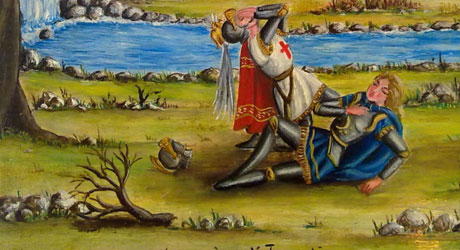
Combattimento di Tancredi e Clorinda
A dramatic work for three voices and orchestra.

A dramatic work for three voices and orchestra.
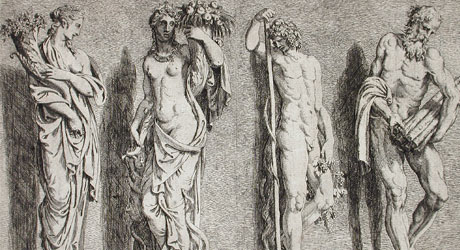
Vivaldi composed “Le Quattro Staggioni” (the Four Seasons) in 1725. The “Seasons” consist of four programmatic concerti for solo violin and orchestra, of which L’Autunno (Autumn) is the third.
Vivaldi wrote descriptive Sonnets for each of the concerti, with indications of how they should be performed.
L’Autunno opens with peasants celebrating the harvest with song and dance. They start drinking wine, become progressively more tipsy, and finally fall asleep. In the hushed second movement, the pleasant temperature causes everyone to abandon singing and dancing, and invites many to enjoy the sweetness of sleep. The last movement describes a hunt, complete with mounted hunters, hunting horns, guns, hounds, and their quarry.
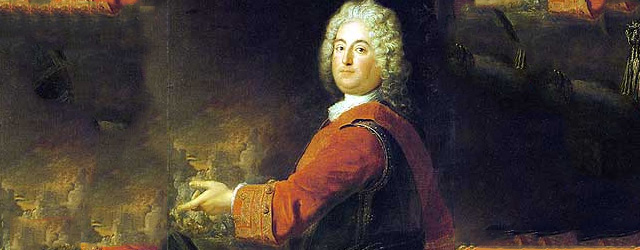
Bach’s six Brandenburg Concertos were dedicated to the Margrave of Brandenburg, and bear a dedication date of 1721.
The instrumentation of the sixth concerto is most unusual, consisting only of violas, violas da gamba, ‘cellos, basses and continuo. This “lower string” instrumentation give the work a harmonious and mellow sonority. We are performing this work in “concerto grosso” style, with viola and ‘cello soloists.
The work is in three movements. The opening Allegro features the main theme in close canon, with the 2 viola parts entering right on the heels of each other, and the other instruments following suit, The following Adagio is a trio sonata in fugal form; the 2 viola soloists alternatively present the theme in various keys. The solo ‘cello and bass pick up the fugal theme towards the end of the movement. The last movement is a joyous ritornello. The string orchestra is juxtaposed against florid passages by the two solo violas and solo ‘cello, with the main theme returning four times.
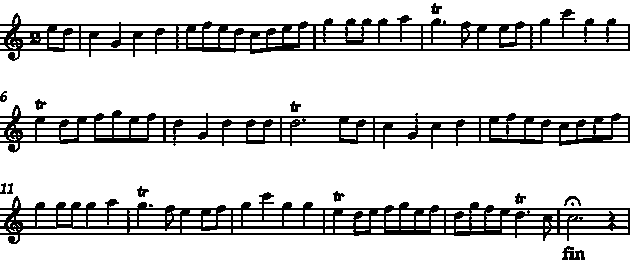
Jean-Joseph Mouret (1682-1738) was a court composer active in France during the reigns of Louis XIV (the “Sun King”) and his son, Louis XV. Very few of his compositions have survived, and even fewer are known to the public.
The major exception is this collection of fanfares known as his “Premiere Suite de Symphonies” which was first performed for Louis XV. The Suite has four movements, each with a different character, and each featuring contrasting forces – strings and woodwinds; trumpets; and timpani.
The Suite opens with a Rondeau, a grand fanfare (also known as the “Masterpiece Theater” theme), with 2 contrasting couplets. The second movement is a graceful minuet, played first by strings and woodwinds, with trumpets and timpani joining in; there are two string couplets in the middle of the movement, followed by a return to the opening minuet. Next is a sprightly march, in 18th-century military style. A short lilting final movement (“Guay”) closes out this work.
Mouret’s formalized style emphasizes rhythmic precision and simplicity of line, and typifies the French style in baroque music.
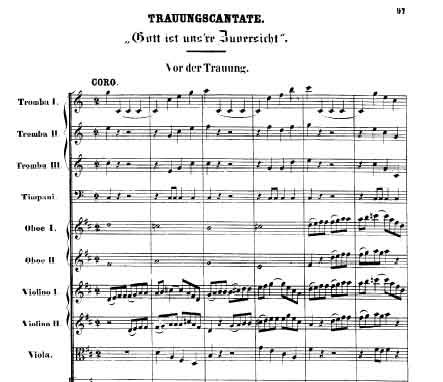
Bach in a more festive mode, now with a wedding cantata, BWV 197, written in 1737. This is the opening chorus in D major. It begins with a rousing introduction for the orchestra with three trumpets, oboes, strings and timpani. A choral fugue follows with altos in the lead. A more lyrical middle section starts in the relative minor key. The piece ends with a repeat of the jubilant first section.
| Gott ist unsre Zuversicht, Wir vertrauen seinen Händen. Wie er unsre Wege führt, Wie er unser Herz regiert, Da ist Segen aller Enden. |
God is our confidence, we trust in His hands. How He leads our ways, how He directs our hearts, that is the ultimate blessing. |
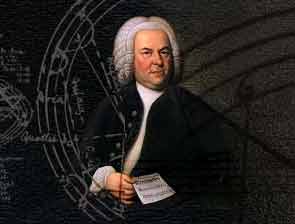
A large number of Bach’s compositions are choral works, most of them centered on the liturgy and church services. They include over 200 sacred cantatas; secular cantatas; monumental works like the B Minor Mass, Christmas and Easter Oratorios, and St. Matthew Passion; and chorales, masses and motets. The motets fall into a special category of smaller-scale works which were often written for special occasions, such as weddings or funerals.
Bach composed this motet in 1736-7, when he was serving as the Cantor at St. Thomas Church in Leipzig. It was most likely written for a funeral. The original instrumentation calls for six brass instruments: 2 “litui” (horn-like instruments), a cornetto, and 3 trombones. The scoring for such portable instruments makes it likely that this introspective motet was used outdoors, either in a procession or a graveside service (Bach later re-orchestrated it for more conventional winds and strings for indoor church use).
The text of BWV 118 is taken from an early 17th-century hymn written by Martin Behm, which contains some 15 stanzas. Bach’s score indicates that multiple stanzas can be used, and for today’s performance we are using 2 of them (1 and 12). The music and text evoke the hope of redemption in death and entry into heaven.
| O Jesu Christ, meins Lebens Licht, Mein Hort, mein Trost, mein Zuversicht, Auf Erden bin ich nur ein Gast, Und drückt mich sehr der Sünden Last. Auf deinen Abschied, Herr, ich trau, |
Oh Jesus Christ, my life’s light, my refuge, my comfort, my confidence, on earth I am only a guest and by sin’s burden sore oppressed. In your departure, Lord, I place my trust— |
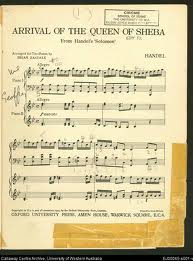
This short well-known work is actually an instrumental interlude contained in the oratorio Solomon, which Handel composed in 1749. The sinfonia contains vigorous running passages in the violins with contrasting oboe solos.
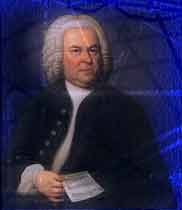
In 1721 Bach dedicated a set of six concerti for diverse instruments to Markgraf Christian Ludwig of Brandenburg. At that time Bach was the resident Kapellmeister for Prince Leopold of Anhalt-Cöthen, and was in the midst of composing some of his best -known instrumental works. The “Brandenburg Concerti” are indeed a remarkable collection, each featuring unique combinations of instruments.
His Concerto No. 1 is noteworthy for featuring two “hunting horns” – the first ever use of horns in such a work. Together with the horns, this work features three oboes, bassoon, solo violin and strings. It has four movements (the only Brandenburg concerto to have that many).
The opening allegro is filled with counterpoint among the horns, oboes, strings and solo violin. The melodious second movement features solo passages in canon between the solo oboe and solo violin. A lively third movement follows, with robust orchestral passages offset by solos. The fourth movement is unique, with an opening menuetto for full ensemble; a trio featuring oboes and bassoon; a “Polacca”, or formal polonaise, section played by the strings; and a second trio featuring horns and oboes.

This is one of Bach’s best-known solo cantatas, and one of the relatively few non-religious cantatas composed by the master. It is scored for solo soprano, three solo instruments (oboe, violin, bassoon), strings and continuo.
It begins with an introspective opening adagio (“Weichet nur, betrübte Schatten”–“Depart melancholy shadows”), with a sinuous duet between the solo oboe and soprano against a background of rising chords in the strings. The following movements describe the sensations, pleasures and fulfillment of love in a series of descriptives recitatives and arias.
Some of the images evoked include the world reborn, and the sun god Phoebus Apollo racing above and inspired to be a lover himself (“Phöbus eilt”); love wafting through the air like spring breezes in a flowery meadow (“Wenn die Frühlingslüfte”); the joy of love, and how to practice it (“Sich üben im Lieben”).
The Cantata ends in a lilting Gavotte, with the hope of a fruitful and contented married future (“Sehet in Zufriedenheit”).

The great Johann Sebastian Bach early on made his mark as a composer and performer on the organ. The D minor Toccata and Fugue is one of his earliest organ works, probably written between 1705 and 1708.
It has 2 main sections – an opening “toccata” (from the Italian “to touch”) with florid passagework and extensive improvisation, and a massive fugue made up of a 2-bar 16th-note theme repeated in various keys against a number of countersubjects.
Leopold Stokowski, the great American conductor, was so taken by the magnificence of this piece that he arranged it for a large orchestra. His arrangement highlights all sections of the orchestra – strings, high winds, low winds, brass – to give the original organ piece many different orchestral colors and sonorities (not to mention massive amounts of tonal volume!). The Stokowski arrangement is featured in the Disney movie Fantasia. Its famous opening theme has become a part of popular culture and been used in many films (horror and otherwise), as well as plays, videos and videogames.